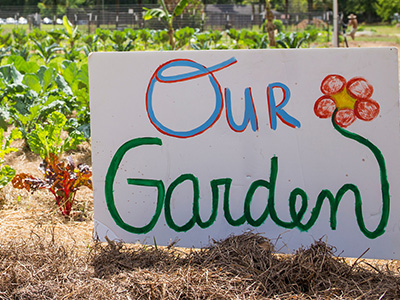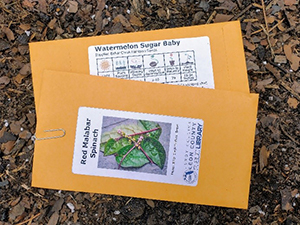Considerations for the New Gardener

Creating an edible landscape doesn’t have to be expensive or hard, but it does take some planning and thought—especially if you hope to do so inexpensively. Here are some general guidelines to keep in mind as you contemplate starting your garden.
Start with a Plan
Decide what you want to grow and determine what will be necessary to be successful. In Florida, you can plant vegetables throughout most or all of the year. Become familiar with which crops do well at certain times of the year. Make a list of what you’d really like to see in your garden and draw your plan out on paper. Read “Designing Your Vegetable Garden” for more information about how to create a visual plan.
Answer these questions to help you to determine your priorities.
- What do you like eating? You’re not likely to take care of, or eat, things you don’t like. So don’t waste your time or money planting them in the garden.
- What fruits and vegetables are the most expensive to buy? To save money, grow more expensive items, like tomatoes and melons, or large quantities of vegetables that you purchase regularly. Consider vegetables like beans, beets, onions, spinach, broccoli, peppers, carrots, summer squash, cucumbers, tomatoes, potatoes, lettuce, peas, and Swiss chard. These vegetables provide the biggest returns on your investment of space and time in the garden.
- Which vegetables can be easily stored or preserved? Selecting vegetables that have a long storage life or that can easily be canned or frozen is a great way to stretch a dollar. Potatoes, onions, sweet potatoes, and winter squash can be stored for several months when stored at the appropriate temperature. Other vegetables, like beans, tomatoes, cucumbers, beets, and sweet corn can be preserved by canning or freezing. Preserving vegetables is a great way to enjoy the extra produce later in the year.
- How much time are you willing to spend? Vegetable gardening takes a commitment of time and energy. Daily and weekly maintenance tasks will be required to get the return on your dollar investment. A smaller garden will require less maintenance, as will certain plants.
- How much space can you devote to an edible garden? Make sure you put your garden in a place that isn’t highly used by children or pets as a play area.
- Am I allowed to start an edible garden? Check with your local regulations, including HOA rules, about starting an edible garden. Read “Am I Allowed to Start a Garden?”

Start Small
Like many things, gardening takes practice. Plants require regular watering, maintenance, and harvesting. Growing many different vegetables in a large garden can be overwhelming for new gardeners and can ultimately lead to failure. Limit yourself to just a few types of vegetables the first year. Then when you become more confident in your abilities and resources, you can increase the size of your vegetable garden and grow a wider variety of crops.
You also don’t want to plant everything at once. During your initial planting, set aside some space and seed for later plantings. If you stagger your plantings every ten or fourteen days, you’ll enjoy a steady supply of fresh produce throughout the season, instead of being overwhelmed with a lot of the same vegetable at once.
Start from Seed
Growing from seed is the most cost-effective way to start your vegetable garden. Most seeds are available to buy from your local garden center. While it may take longer and require advance planning, starting the majority of your plants from seed can be a big savings, especially if you’re using recycled containers.
Here’s a sample comparison: One packet of tomato seed is about equivalent to the price of one tomato seedling, yet you get the potential of at least 30–40 plants in each packet.
And to get your seeds going, there’s no need for expensive heat mats—the top of the VCR or water heater is ideal. Fluorescent tubes make a suitable substitute for expensive grow lights and can be rigged up under a table or on a shelf in the garage.
Here are some more money-saving tips.

Shop discount stores. Discount stores often have a small garden section offering several varieties of seed packets. Check them out and see what is available.
Participate in a seed exchange. Seed exchanges are a great way to get free seeds and discover new varieties. You can find them online at garden forums or you can organize one with friends. When you’re trading seeds just remember to label the packets and mark how old the seeds are. This is a great way to discover new varieties and meet new (and helpful) friends. Speaking of friends…
Check with gardening friends. If you know gardeners locally who are growing their own fruits or vegetables, it’s sometimes worthwhile asking about their crops. Lots of experienced gardeners love to help beginners onto the “growing your own” wagon and will sometimes offer some seeds for free.
Save your own seed. You may want to try growing fruits and vegetables from seeds obtained from your own plants. This small up-front investment may mean you never have to buy that plant again once you have your own crop. Not only will you save on the seed purchase the following year, but you’ll also be able to select seed from plants that you know did well in your climate. Most communities now arrange for seed swaps in the early spring where you can trade your excess seed for new varieties. Just make sure that you save seed from non-hybrid plants, because hybrids are often sterile.
Buy seed in bulk. Many seed catalogs sell seed packets in different sizes. The bigger the packet you buy, the more you can potentially save! Get together with a group of friends to order your favorite seeds together and you can save 25 percent or more of your money.
Also on Gardening Solutions
Sustainable Home Food Production Series
With renewed interest in growing produce at home, we’ve developed a series of articles, Sustainable Home Food Production.
